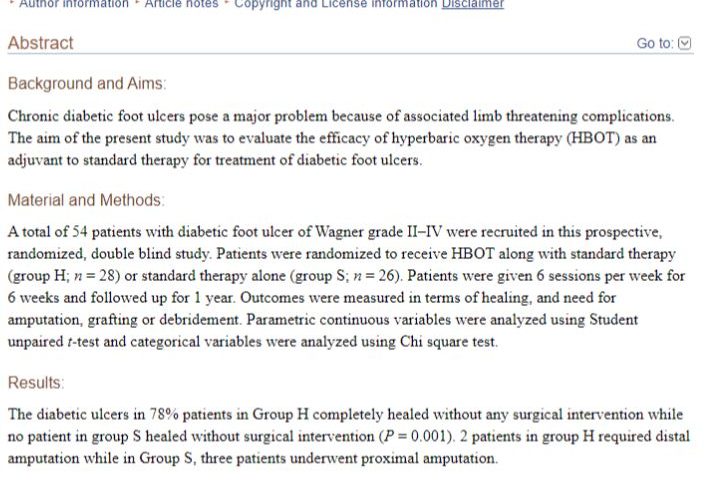Ossigeno terapia iperbarica e piede diabetico

Il tema dell’uso di OTI nel trattamento dei pazienti affetti da piede diabetico è molto dibattuto in ambito scientifico.
L’estrema complessità della gestione di questi pazienti e le notevoli ripercussioni sui meccanismi fisiologici dell’organismo colpito da diabete rendono difficili e con peggioramento della prognosi gli interventi medico-chirurgici nell’affrontare le complicanze che si possono sviluppare.
In particolare la presenza di ulcere alle estremità inferiori sono una sfida per tutti gli specialisti coinvolti nella gestione dei pazienti affetti.
I risultati di questo studio prospettico randomizzato su 54 pazienti (28 che ricevevano terapia standard e OTI e 26 solo terapia standard) mostrano come il 78% dei pazienti nel gruppo OTI è guarito completamente, senza ricorrere a interventi chirurgici, mentre nessuno dei pazienti nel gruppo di controllo è guarito se non
dopo intervento chirurgico.
Fra i pazienti del gruppo OTI due sono andati incontro ad amputazione distale, mentre tre nel gruppo controllo hanno subito un’amputazione prossimale.
Gli autori concludono che OTI, affiancata alle terapie standard, potrebbe essere adiuvante nel determinare una miglior prognosi nei pazienti affetti da piede diabetico.
Hyperbaric oxygen therapy as an adjuvant to standard therapy in the treatment of diabetic foot ulcers
Background and Aims:
Chronic diabetic foot ulcers pose a major problem because of associated limb threatening complications. The aim of the present study was to evaluate the efficacy of hyperbaric oxygen therapy (HBOT) as an adjuvant to standard therapy for treatment of diabetic foot ulcers.
Material and Methods:
A total of 54 patients with diabetic foot ulcer of Wagner grade II–IV were recruited in this prospective, randomized, double blind study. Patients were randomized to receive HBOT along with standard therapy (group H; n = 28) or standard therapy alone (group S; n = 26). Patients were given 6 sessions per week for 6 weeks and followed up for 1 year. Outcomes were measured in terms of healing, and need for amputation, grafting or debridement. Parametric continuous variables were analyzed using Student unpaired t-test and categorical variables were analyzed using Chi square test.
Results:
The diabetic ulcers in 78% patients in Group H completely healed without any surgical intervention while no patient in group S healed without surgical intervention (P = 0.001). 2 patients in group H required distal amputation while in Group S, three patients underwent proximal amputation.
Conclusion:
The present study shows that hyperbaric oxygen therapy is a useful adjuvant to standard therapy and is a better treatment modality if combined with standard treatment rather than standard treatment alone for management of diabetic foot ulcers.
